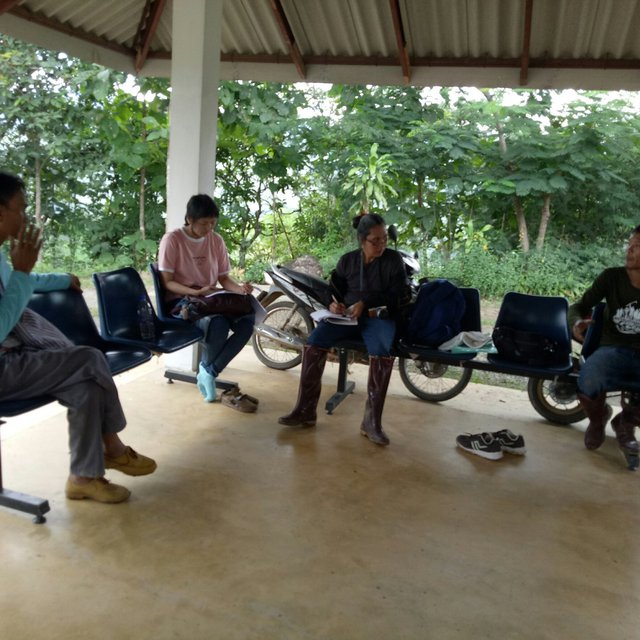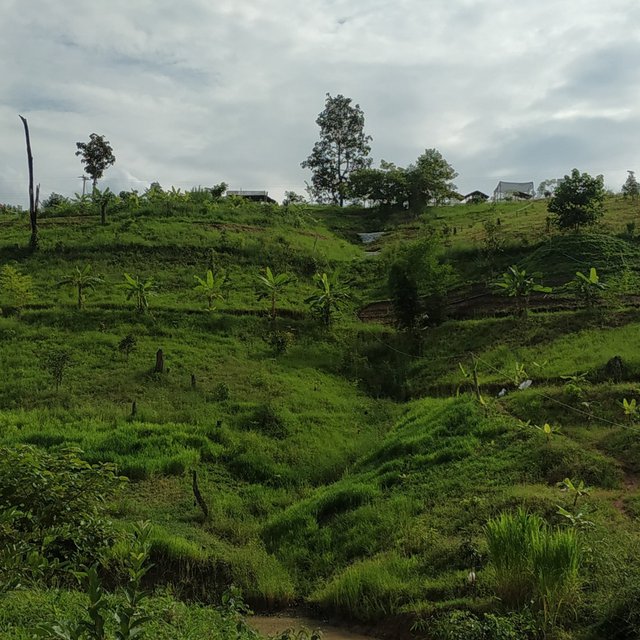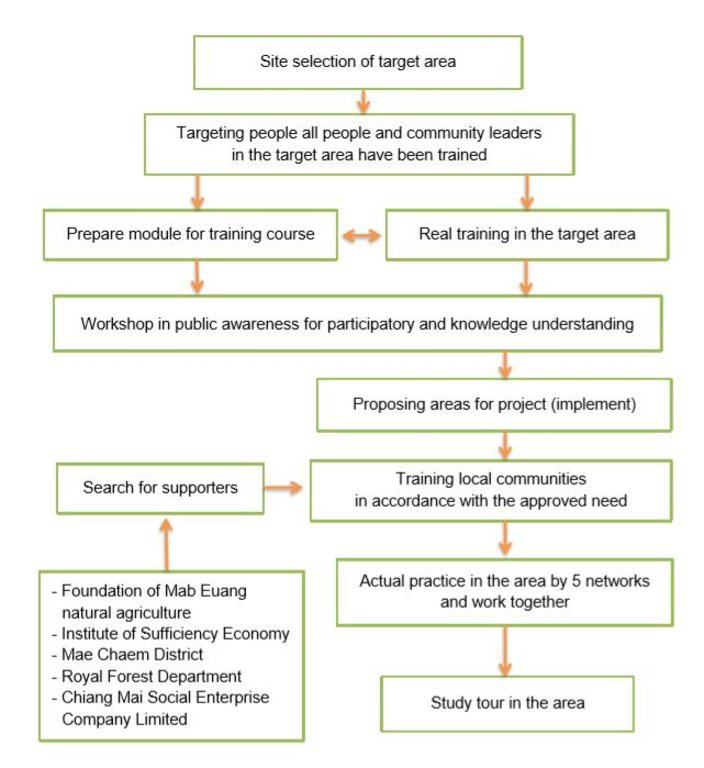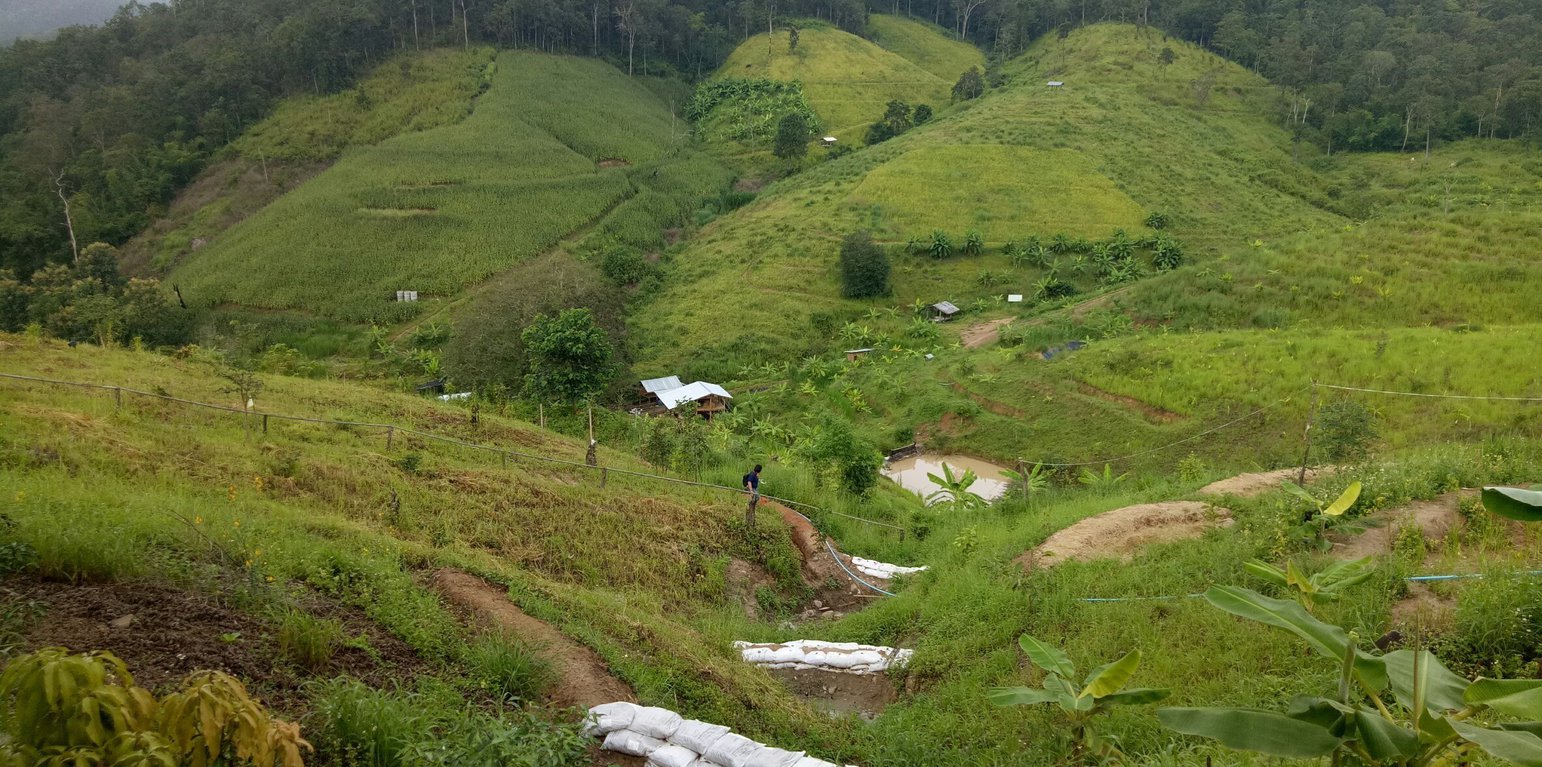Returning Life to Mae Chaem Watershed by Integrated Land and Water Management
(ໄທ)
Integrated land and water management in landscape of Khok-Nong-Na model
ຄຳອະທິບາຍ
The promotion of a model that supports sustainable cultivation outside the protected forest area in the northern highlands of Thailand. The model is based on the knowledge of King Bhumibol Adulyadej (King Rama 9). It is a prototype model of the Institute of Sufficiency Economy and the Foundation for Natural Agriculture, and uses the New Theory Approach in Agriculture to build a self-sufficiency economy.
This is the approach that supports "returning life" to the Mae Chaem area by an integrated land and water management system in the highlands, through the King Rama 9 initiative combined with local wisdom: or the "Khok-Nong-Na model". Most of this area is in Mae Chaem Reserved National Forest, an upstream watershed which is strictly preserved as forest and does not officially allow people to live and cultivate. However, communities have been earning their living there for a long time before the reserved forest law was announced, which deprived them of the right to own the land and use it for agriculture. Previously all land users earned income by encroaching into Mae Chaem National Forest Reserve - and converting it into maize, shallot and cabbage fields. The forest area was intruded upon, making the soil erode, and therefore soil fertility and productivity decreased. The integrated water management system by King Rama 9’s initiative together with local wisdom, is a prototype model at the Sufficiency Economy Institute and the Natural Agriculture Foundation, supporting the “New Theory of Agriculture” based on a self-sufficiency economy. The Foundation has explained to all land users that this concept called "Khok-Nong-Na" divides the area into 30:30:30:10 portions as follows; 30% for water sources (farm ponds, small water channels), 30% for rice fields, 30% for trees, and 10% for housing and animals. Implementation of Khok-Nong-Na models will depend on the topography of the area are as follow:
1. Upland or "mound" (Khok) is the highland area as part of the mountain or hill to cultivate "three kinds of trees” as forests, namely "three forests, four benefits". “Three kinds of forests” means for consumption, construction and economy, while the fourth benefit is to preserve the ecosystem.
2. Reservoir (Nong), the lowland area as part of water resources, includes the checkdam or weir, the sediment trap, the water channel and the pond, for both consumption and agricultural use. The checkdam or weir in the upper area serves as a storage and to control the flow rate of water. The water channel is designed to deliver water to the pond or reservoir in the lower area.
3. Paddy field (Na) is an important component for rice cultivation because rice is the main staple. Rice terraces are established in the sloping area, with paddy fields in the lowland. The main purpose of rice production is for the farmer family’s consumption - as well as for income. The ridges around the rice terraces field should be high and wide to store greater amounts of water - as the water level in the paddy field can control weeds, accelerate plant growth and improve crop yields. The native rice variety grown in rich soil is immune to diseases and insects.
ສະຖານທີ່

ສະຖານທີ່: Ban Thap Sub-district, Mae Chaem District, Ban Thap Sub-district, Mae Chaem District, Chiang Mai Province, ໄທ
ການຄັດເລືອກພື້ນທີ່ ທີ່ອີງໃສ່ຂໍ້ມູນທາງພູມີສາດ
ວັນທີເລີ່ມຕົ້ນ: 2015
ປີຂອງການສິ້ນສຸດ: n.a.
ປະເພດຂອງແນວທາງ
-
ພື້ນເມືອງ / ທ້ອງຖີ່ນ
-
ການລິເລີ່ມ ພາຍໃນປະເທດ ທີ່ຜ່ານມາ / ນະວັດຕະກໍາ
-
ພາຍໃຕ້ໂຄງການ / ແຜນງານ

Interview land users and local officers in this area (Ms.Tanomkhaw Thipwong)

They have soil and water conservation measures in the sloping area. (Ms.Tanomkhaw Thipwong)
ເປົ້າໝາຍຂອງແນວທາງ ແລະ ການປົກປັກຮັກສາສິ່ງແວດລ້ອມ
ເປົ້າໝາຍ / ຈຸດປະສົງຫຼັກໃນການຈັດຕັ້ງປະຕິບັດແນວທາງ
The integrated land management of Khok-Nong-Na model "returns life to the watershed" by protecting the ecosystem and simultaneously promoting sustainable and productive farming.
ເງື່ອນໄຂທີ່ສະໜັບສະໜູນໃຫ້ການຈັດຕັ້ງປະຕິບັດເຕັກໂນໂລຢີ ບົນພື້ນຖານແນວທາງ
-
ການຮ່ວມມື / ການປະສານງານຂອງຜູ້ກ່ຽວຂ້ອງ: Almost all land users help each other and collaborate to work together around twice a week.
ເງື່ອນໄຂທີ່ເຊື່ອງຊ້ອນໃຫ້ການຈັດຕັ້ງປະຕິບັດເຕັກໂນໂລຢີ ບົນພື້ນຖານແນວທາງ
-
ມີຄວາມສາມາດ / ເຂັ້າເຖິງຊັບພະຍາກອນດ້ານການເງິນ ແລະ ການບໍລິການ: They should stop borrowing money as they cannot find money to clear their debts.
-
ວຽກ, ມີກໍາລັງຄົນ: They have more workload in their field to do comfortably in one day and there are no labourers to hire in this area.
ການມີສ່ວນຮ່ວມ ແລະ ບົດບາດຂອງພາກສ່ວນທີ່ກ່ຽວຂ້ອງທີ່ມີສ່ວນຮ່ວມ
ພາລະບົດບາດຂອງພາກສ່ວນທີ່ກ່ຽວຂ້ອງ ທີ່ມີສ່ວນຮ່ວມໃນການຈັດຕັ້ງປະຕິບັດແນວທາງ
| ແມ່ນໃຜ / ພາກສ່ວນໃດ ທີ່ເປັນເຈົ້າການ ໃນການຈັດຕັ້ງປະຕິບັດ ວິທີການ? |
ລະບຸ ພາກສ່ວນທີ່ກ່ຽວຂ້ອງ |
ພັນລະນາ ບົດບາດ ໜ້າທີ່ ຂອງພາກສ່ວນທີ່ກ່ຽວຂ້ອງ |
| ຜູ້ນໍາໃຊ້ດິນໃນທ້ອງຖິ່ນ / ຊຸມຊົນທ້ອງຖິ່ນ |
Household network covers 21 members |
All land users cooperate with each others |
| ອົງການຈັດຕັ້ງ ທີ່ບໍ່ຂື້ນກັບລັດຖະບານ |
Natural Agriculture Study Center |
Support all knowledge in the New Theory for Agriculture (King Rama 9) |
| ພາກເອກະຊົນ |
Chiang Mai Social Enterprise Company Limited |
Support seed of some crops and saplings of trees and fruit trees |
| ອໍານາດ ການປົກຄອງທ້ອງຖິ່ນ |
Royal Forest Department and Mae Chaem District Administrative Organization |
Create a project to manage to obtain multiple benefits from the forest for sustainable development by King Rama 9. |
ການລວບລວມເອົາຜູ້ນໍາໃຊ້ທີ່ດິນໃນທ້ອງຖິ່ນ/ຊຸມຊົນທ້ອງຖິ່ນ ໃນການຈັດຕັ້ງປະຕິບັດແນວທາງ ແຕ່ລະໄລຍະ
ບໍ່ມີ
ການບໍ່ປະຕິບັດ
ການຊ່ວຍເຫຼືອຈາກພາຍນອກ
ການຮ່ວມມື
ການນໍາໃໍຊ້ເອງ
ການເລີ່ມຕົ້ນ / ແຮງຈູງໃຈ
All land users normally face drought condition, making them unable to produce agricultural products properly, causing insufficient income and the debts of land users accumulate.
ການວາງແຜນ
Mae Chaem District Office set up a project to return life to all land users, so they can join and work together.
ການປະຕິບັດ
Land users work together with several networks in Khok-Nong-Na model with support from the Royal Forest Department, Natural Agriculture Study Center, Mae Chaem District Office and Chiang Mai Social Enterprise Company Limited.
ຕິດຕາມກວດກາ / ການປະເມີນຜົນ
Monitor, evaluate and follow up by Deputy Minister of Agriculture and Cooperatives and Natural Agriculture Study Center with local officers in the area.
ແຜ່ນວາດສະແດງ
Flow chart Operating procedures:
1. Site selection: the target area will be seen through 5 aspects: community, temple, school, government agency and appropriate topography, with 5 strong network sectors as: government, academic, private, civil social and mass media for sustainability and expansion of civil state
2. Targeting people: all people and community leaders in the target area have been trained at the Mab-Euang Natural Agriculture Foundation.
3. Training course: the main content is agricultural development to the sufficiency economy system by the Natural Agriculture Network. This is to take 5 days and 4 nights, consisting of application of New Theory of Agriculture in the concept of sufficiency economy combined with local wisdom for soil and water management for agricultural area.
4. Workshop: this activity is organized for farmers to learn about participation, extension and to understand the concept of sufficiency economy system.
5. Joint activity: people and communities in the area propose to implement this project and staff of the study center will consider and, when appropriate, approve the project.
6. Finding support agencies: the Mab-Euang Natural Agriculture Center for Sufficiency Economy System, Mae Chaem District Office, Royal Forest Department and Chiang Mai Enterprise Social Enterprise Company Limited.
7. Field training: this activity is the real field training in the selected area, where land users and community members have been trained according to the concept of Khok-Nong-Na model.
8. Area improvement: the practices in the targeted area consist of 5 networks that work together in the land user’s area in the concept of Khok-Nong-Na model with trees and fruit trees in upland and rice cultivation in lowland or rice terraces in upland, including farm ponds. Moreover, this area will be the training and study site for other people in this area.
9. Study center: if this area is completely set up and all components of the Khok-Nong-Na model are installed, the site should be upgraded to be a study center in the future. Now this project has increased cooperation among agencies, i.e. Royal Irrigation Department, Land Development Department, both under the Ministry of Agriculture and Cooperatives, Ministry of Natural Resources and Environment, and Department of Local Administration, Ministry of the Interior.

ຜູ້ຂຽນ: Ms. Somjit Lertdisayawan
ການຕັດສິນໃຈໃນການເລືອກເຕັກໂນໂລຢີ ການຄຸ້ມຄອງທີ່ດິນແບບຍືນຍົງ
ການຕັດສິນໃຈໂດຍ
-
ຜູ້ນໍາໃຊ້ດິນຜູ້ດຽວ (ການລິເລີ່ມດ້ວຍຕົນເອງ)
-
ຜູ້ນໍາໃຊ້ທີ່ດິນຫຼັກ, ການສະໜັບສະໜູນ ໂດຍຜູ້ຊ່ຽວຊານ ການນໍາໃຊ້ທີ່ດິນແບບຍືນຍົງ
-
ພາກສ່ວນກ່ຽວຂ້ອງທັງໝົດ, ເປັນສ່ວນໜຶ່ງ ຂອງວິທີທາງແບບມີສ່ວນຮ່ວມ
-
ຜູ້ຊ່ຽວຊານ ຫຼັກດ້ານການຄຸ້ມຄອງ ທີ່ດິນແບບຍືນຍົງ, ມີການຕິດຕາມປຶກສາຫາລືກັບຜູ້ນໍາໃຊ້ທີ່ດິນ
-
ຊຽ່ວຊານ ສະເພາະດ້ານການຄຸ້ມຄອງ ດິນແບບຍືນຍົງຜູ້ດຽວ
-
ນັກການເມືອງ / ຜູ້ນໍາ
ການຕັດສິນໃຈບົນພື້ນຖານ
-
ປະເມີນເອກກະສານ ຄວາມຮູ້ກ່ຽວກັບ ການຄຸ້ມຄອງ ທີ່ດິນແບບຍືນຍົງ (ຫຼັກຖານທີ່ຊ່ວຍໃນການຕັດສິນໃຈ)
-
ຜົນທີ່ໄດ້ຮັບ ຈາກການຄົ້ນຄວ້າ
-
ປະສົບການສ່ວນບຸກຄົນ ແລະ ຄວາມຄິດເຫັນ (ທີ່ບໍ່ເປັນເອກກະສານ)
ການສະໜັບສະໜູນເຕັກໂນໂລຢີ, ການສ້າງຄວາມອາດສາມາດ ແລະ ການຄຸ້ມຄອງຄວາມຮູ້
ກິດຈະກຳ ດັ່ງລຸ່ມນີ້ ແມ່ນເປັນພາກໜຶ່ງຂອງແນວທາງ
-
ການສ້າງຄວາມສາມາດ / ການຝຶກອົບຮົມ
-
ການບໍລິການໃຫ້ຄໍາປຶກສາ
-
ສະຖາບັນການສ້າງຄວາມເຂັ້ມແຂງ (ການພັດທະນາອົງການຈັດຕັ້ງ)
-
ຕິດຕາມກວດກາ ແລະ ປະເມີນຜົນ
-
ການຄົ້ນຄວ້າ
ການສ້າງຄວາມອາດສາມາດ / ຝຶກອົບຮົມ
ໄດ້ສະໜັບສະໜູນຝຶກອົບຮົມໃຫ້ແກ່ພາກສ່ວນກ່ຽວຂ້ອງດັ່ງລຸ່ມນີ້
-
ຜູ້ນໍາໃຊ້ດິນ
-
ພະນັກງານພາກສະໜາມ / ທີ່ປຶກສາ
ຮູບແບບການຝຶກອົບຮົມ
-
ການເຮັດຕົວຈິງ
-
ຕົວຕໍ່ຕົວ
-
ເນື້ອທີ່ສວນທົດລອງ
-
ກອງປະຊຸມ
-
ຫຼັກສູດ
ກວມເອົາຫົວຂໍ້
Agricultural development to achieve a self-sufficiency economy system.
ການບໍລິການທາງດ້ານການໃຫ້ຄໍາປຶກສາ
ໄດ້ຮັບການບໍລິການທາງດ້ານການໃຫ້ຄໍາປຶກສາ
-
ໃນພື້ນທີ່ຂອງຜູ້ນໍາໃຊ້ດິນ
-
ສູນຄົ້ນຄວ້າ
Monitor, evaluate and follow up in the area.
ຄວາມເຂັ້ມແຂງຂອງສະຖາບັນ
ສະຖາບັນ ໄດ້ຮັບການສ້າງຄວາມເຂັ້ມແຂງ
-
ບໍ່ມີ
-
ມີ, ໜ້ອຍໜຶ່ງ
-
ມີ, ພໍສົມຄວນ
-
ມີ, ຫຼາຍ
ໃນລະດັບດັ່ງລຸ່ມນີ້
-
ທ້ອງຖິ່ນ
-
ລະດັບພາກພື້ນ
-
ແຫ່ງຊາດ
ອະທິບາຍສະຖາບັນ, ພາລະບົດບາດແລະຄວາມຮັບຜິດຊອບ, ສະມາຊິກ, ແລະອື່ນໆ.
At present there are 21 household members in the group. There are rules and guidelines that indicate they must hold meetings and work together twice a week.
ຮູບແບບການສະໜັບສະໜູນ
-
ທາງດ້ານການເງິນ
-
ການສ້າງຄວາມອາດສາມາດ / ການຝຶກອົບຮົມ
-
ອຸປະກອນ
ລາຍລະອຽດເພີ່ມເຕີມ
Tools to work in the area as spade, shovel, ploughs and also saplings of trees and fruit trees, and the costs for travelling, fuel and food when they work together.
ການຕິດຕາມ ແລະ ປະເມີນຜົນ
Monitor, evaluate and follow up by Natural Agriculture Study Center and also local officers.
ການສະໜັບສະໜູນທາງດ້ານການເງິນ ແລະ ອຸປະກອນຈາກພາຍນອກ
ງົບປະມານປະຈຳປີ ໃນກິດຈະກຳ ການຄຸ້ມຄອງທີ່ດິນແບບຍືນຍົງ ທີ່ເປັນສະກຸນເງິນໂດລາ
-
< 2,000
-
2,000-10,000
-
10,000-100,000
-
100,000-1,000,000
-
> 1,000,000
Precise annual budget: n.a.
ການບໍລິການ ຫຼື ສິ່ງກະຕຸກຊຸກຍູ້ ດັ່ງລຸ່ມນີ້ ແມ່ນໄດ້ສະໜອງໂດຍຜູ້ນຳໃຊ້ທີ່ດິນເອງ
-
ການສະໜັບສະໜູນ ທາງດ້ານການເງິນ / ອຸປະກອນ ສະໜອງໃຫ້ແກ່ຜູ້ນໍາທີ່ດິນ
-
ຫຼຸດປັດໃຈນໍາເຂົ້າ
-
ສິນເຊື່ອ
-
ສິ່ງຈູງໃຈ ຫຼື ເຄື່ອງມືອື່ນໆ
ເງິນສະໜັບສະໜູນອຸປະກອນ / ສະໜອງໃຫ້ຜູ້ຊົມໃຊ້ທີ່ດິນ
Agricultural equipment for land users to set up Khok-Nong-Na model such as spade, shovel, plough and also saplings of soil, trees and fruit trees by the Deputy Minister of Agriculture and Cooperatives, and Natural Agriculture Study Center.
ງົບປະມານບາງສ່ວນ
ງົບປະມານເຕັມສ່ວນ
ອຸປະກອນ: ເຄື່ອງມື
Material and equipment for farming
ກະສິກໍາ: ແນວພັນ, ແກ່ນພັນ
Seed of crops and saplings of trees and fruit trees
ແຮງງານຂອງຜູ້ນໍ້າໃຊ້ທີ່ດິນ
-
ການອາສາ
-
ລ້ຽງເຂົ້າ - ອາຫານ
-
ຈ່າຍເປັນເງິນສົດ
-
ໄດ້ຮັບການສະໜັບສະໜູນ ອຸປະກອນດ້ານອື່ນ
ສີ່ງກະຕຸກຊຸກຍູ້ອື່ນໆ
n.a.
ການວິເຄາະຜົນກະທົບ ແລະ ສະຫຼຸບລວມ
ຜົນກະທົບຂອງການນໍາໃຊ້ແນວທາງ
ບໍ່
ມີ, ໜ້ອຍໜຶ່ງ
ມີ, ພໍສົມຄວນ
ມີ, ຫຼາຍ
ການນໍາໃຊ້ ວິທີທາງ ສາມາດປັບປຸງຄວາມຮູ້ ແລະ ຄວາມສາມາດຂອງຜູ້ນໍາໃຊ້ທີ່ດິນ ໃນການປະຕິບັດ ການຄຸ້ມຄອງ ທີ່ດິນແບບຍືດຍົງໄດ້ບໍ່?
All land users are trained to set up the Khok-Nong-Na model.
ການຈັດຕັ້ງປະຕິບັດ ວິທີທາງ ສາມາດປັບປຸງ ປະເດັນການຖືຄອງທີ່ດິນ / ສິດທິໃນການນໍາໃຊ້ທີ່ດິນ ທີ່ເຊື່ອງຊ້ອນໃນການຈັດຕັ້ງປະຕິບັດ ເຕັກໂນໂລຢີ ການຄຸ້ມຄອງ ທີ່ດິນແບບຍືນຍົງໄດ້ບໍ?
ການນໍາໃຊ້ ວິທີທາງ ໄດ້ປັບປຸງ ການນໍາໃຊ້ແຫຼ່ງພະລັງງານ ແບບຍືນຍົງຫຼາຍຂື້ນບໍ່?
ສິ່ງກະຕຸກຊຸກຍູ້ໃຫ້ຜູ້ນໍາໃຊ້ທີ່ດິນ ໃນການປະຕິບັດການຄຸ້ມຄອງທີ່ດິນແບບຍືນຍົງ
-
ການຜະລິດເພີ່ມຂຶ້ນ
-
ກໍາໄລເພີ່ມຂຶ້ນ (ຄວາມສາມາດ), ການປັບປຸງຄ່າໃຊ້ຈ່າຍ, ຜົນປະໂຫຍດ, ອັດຕາສ່ວນ
-
ຫຼຸດຜ່ອນດິນເຊື່ອມໂຊມ
-
ຫຼຸດຜ່ອນຄວາມສ່ຽງຂອງໄພພິບັດ
-
ການຫຼຸດຜ່ອນພາລະວຽກ
-
ການຊໍາລະເງິນ / ເງິນອຸດໜູນ
-
ກົດລະບຽບແລະລະບຽບການ (ລະອຽດ) / ການບັງຄັບໃຊ້
-
ກຽດສັກສີ, ຄວາມກົດດັນທາງສັງຄົມ / ການຕິດຕໍ່ກັນທາງສັງຄົມ
-
ລວມເຂົ້ານໍາກັນກັບການເຄື່ອນໄຫວ / ໂຄງການ / ກຸ່ມ / ເຄືອຂ່າຍ
-
ຄວາມຮັບຮູ້ ທາງສີ່ງແວດລ້ອມ
-
ພາສີ ແລະ ຄວາມເຊື່ອຖື, ສົມບັດສິນທໍາ
-
ການປັບປຸງ ຄວາມຮູ້ ແລະ ຄວາມສາມາດ ຂອງການຄຸ້ມຄອງ ທີ່ດິນແບບຍືນຍົງ
-
ການປັບປຸງຄວາມງົດງາມ
-
ການຫຼຸດຜ່ອນຂໍ້ຂັດແຍ່ງ
ຄວາມຍືນຍົງຂອງການຈັດຕັ້ງປະຕິບັດກິດຈະກໍາຂອງແນວທາງ
ຜູ້ນໍາໃຊ້ທີ່ດິນ ສາມາດຈັດຕັ້ງປະຕິບັດຕາມແນວທາງໄດ້ເອງບໍ່ (ໂດຍປາດສະຈາກການສະໜັບສະໜູນຈາກພາກສ່ວນພາຍນອກ)?
ບົດສະຫຼຸບ ແລະ ບົດຮຽນທີ່ໄດ້ຮັບ
ຄວາມເຂັ້ມແຂງ: ທັດສະນະມູມມອງ ຂອງຜູ້ນໍາໃຊ້ທີ່ດິນ
-
Improve and restore natural resources, i.e. environment, soil, water, and forest .
-
This system would save labor, fuel and material cost of pumping water into the fields for fruit trees and various crops.
-
The network members are harmonious and work together under the regulations and rules.
ຄວາມເຂັ້ມແຂງ: ທັດສະນະມຸມມອງ ຂອງຜູ້ປ້ອນຂໍ້ມູນເອງ
-
Many official and private agencies cooperate to work with strong network and community, so land users will use their land for agricultural activities and at the same time they would help in reforestation.
-
This model will discourage all land users to do their slash-and-burn practice.
ຈຸດອ່ອນ / ຂໍ້ເສຍ / ຄວາມສ່ຽງ: ທັດສະນະມູມມອງ ຂອງຜູ້ນໍາໃຊ້ທີ່ດິນວິທີການແກ້ໄຂແນວໃດ
-
Farmers have more work load per day to do it comfortably.
That is good to improve their soil and increase their products and income.
-
They have not yet started to earn money at this time and have no ability to reduce their debts.
They would like the government to help with their debts.
-
None
ຈຸດອ່ອນ / ຂໍ້ເສຍ / ຄວາມສ່ຽງ: ທັດສະນະມຸມມອງ ຂອງຜູ້ປ້ອນຂໍ້ມູນເອງວິທີການແກ້ໄຂແນວໃດ
-
At the first stage they cannot produce agricultural products because they do not have enough water.
Local officers should recommend some short-period plants to generate income.
-
This area has organic and green vegetable market in schools and hospitals nearby but farmers cannot produce sufficiently to serve the demand of that market.
This model should serve to help store more water in their area, to be sufficient for agricultural production.
-
None
ເອກກະສານອ້າງອີງ
ການທົບທວນຄືນ
-
Rima Mekdaschi Studer
-
William Critchley
ວັນທີຂອງການປະຕິບັດ: Dec. 21, 2018
ປັບປຸງລ່າສຸດ: Jan. 13, 2021
ບຸກຄົນທີ່ສໍາຄັນ
-
Somjit Lertdisayawan (ktb.somjit@gmail.com) - co-compiler
-
Sasirin Srisomkiew (sasirin_ldd@hotmail.com) - co-compiler
-
Tanomkwan Tipvong (aoy.tvong@gmail.com) - co-compiler
ການບັນຍາຍລາຍລະອຽດ ໃນຖານຂໍ້ມູນ ຂອງ WOCAT
ຂໍ້ມູນການເຊື່ອມໂຍງຂໍ້ມູນການຄຸ້ມຄອງການນໍາໃຊ້ດິນແບບຍືນຍົງ
ເອກກະສານ ແມ່ນໄດ້ອໍານວຍຄວາມສະດວກໂດຍ
ເຊື່ອມໂຍງກັບ ຂໍ້ມູນຕ່າງໆ ທີ່ກ່ຽວຂ້ອງທີ່ມີ







